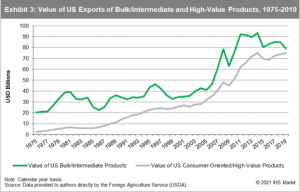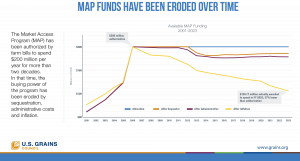
Swipe For More >
International trade is a vital component of a nation’s GDP calculation and serves as a key indicator of economic health and development. Exports have a large impact on the United State’s economy and on average account for roughly 10% of GDP. Since the 1960’s, agricultural exports have significantly contributed to the value of U.S. exports, reaching $3 trillion in 2022. With continued investment in international markets, particularly through USDA Export Market Development Programs, there are considerable growth opportunities for the sorghum industry in both economic scale and producer well-being.
These market development programs, facilitated by USDA’s Foreign Agricultural Service (FAS), provide agents in the U.S. agricultural industry opportunities to enhance their influence abroad through partnership programs. Two notable initiatives included in this category are the Market Access Program (MAP) and the Foreign Market Development (FMD) program.
MAP focuses on consumer-oriented promotion and marketing of U.S. commodities and branded products. It is implemented through a range of methods including technical assistance, trade fairs, product demonstrations and other “hands-on” product advancement. FMD is dedicated to more generic promotion of U.S. commodities and is colloquially referred to as the “Cooperator Program.” Through FMD, agricultural non-profit organizations and trade associations partner with FAS to invest in long-term export market expansion and development as well as reduction of trade barriers.
The United Sorghum Checkoff Program participates in the MAP and FMD Programs through partnership with the U.S. Grains Council (USGC), which effectively acts as the commodity’s “export arm”. The USGC is allotted a cost-sharing budget of $7.89 million through MAP projects and $3.3 million through FMD projects. These funds are strategically allocated among the various bulk grains represented by USGC to increase the value of U.S. grain abroad. A report on the economic impact of USDA Market Development Programs, prepared in February 2022 by IHS Market, a provider of financial market analysis, shows the value of bulk/intermediate exports has consistently increased from 1975 to 2019. This upward trend, spanning 44 years, has resulted in an increase of $60 billion, indicating the valuable impact market development programs have made for U.S. agriculture.

According to USDA’s Economic Research Service, the estimated return of investment on U.S. agricultural exports is profound. With every $1000 invested in international market promotion, there is a remarkable return of $1800, almost doubling the foundational investment. Further analysis of MAP and FMD’s economic impact to U.S. agricultural exports reveals that from 1975 to 2019, an average of $9.6 billion has been added annually to agricultural export value. Over this same period, there was an annual lift in export revenues of 13.7%.
These programs not only boost export volume and value, but also make substantial contributions to the broader national economy. Results from the previously mentioned IHS Market Report show that from 2002 to 2019, MAP and FMD contributed $45 billion in economic output, $22.3 billion in GDP, and $9.8 billion in annual labor income. Furthermore, the effect of these programs extends to producers through tangible economic impact for producers at the microeconomic level. During the 17 years between 2019 and 2002, MAP and FMD added $12.2 billion annually to farm cash receipts, which translates to a $3.1 billion increase in annual net cash farm income.
Given the demonstrated impact, it is evident that the USDA’s cost-share programs, MAP and FMD, have effectively boosted agricultural export revenue and volume, enhanced the national economy, and benefited producers. Under the 2018 Farm Bill, MAP and FMD were allotted a total of $234.5 million. Although this appears to be a substantial sum, it does not accurately reflect the amount that is used to promote U.S. commodities like sorghum. According to USGC, after inflation, sequestration and administrative costs are accounted for, only $125 million of the $200 million allotted to MAP (a difference of 37.5%) is utilized for market promotion.

As development of the 2023 Farm Bill is underway, National Sorghum Producers is focused on ensuring MAP and FMD programs, which have a beneficial impact on U.S. sorghum, not only retain funding, but also receive an increase in funds. Simulation of a doubled funding scenario over the course of 2024-2029 estimates an additional $44 billion in U.S. agricultural exports, an average annual increase of $6 billion in GDP, and an average annual increase of $630 million in net cash farm income.
In late October, USDA announced allocation of $2.3 billion from the Commodity Credit Corporation (CCC) for the Regional Agricultural Promotion Program (RAPP). This investment was introduced in order to address the current trade deficit, diversify export markets and combat global food insecurity. In response to the RAPP announcement industry groups thanked USDA for its continued promotion of market development. The USGC expressed its intent to use RAPP as a means of supplementing MAP and FMD funds, similarly to how it has utilized the Agricultural Trade Promotion (ATP) to advance sorghum and other grains. While increased funding for these programs is important, NSP will continue to push for increased long-term funding of the MAP and FMD programs in a new farm bill.
The agricultural industry, as a whole, greatly benefits from these market development programs. As sorghum continues to be a foundational crop in resource conservation, a staple for both animal and human consumption and a leading grain in food aid, the commodity reflects the importance of MAP and FMD to the industry’s growth and success. Through support of and participation in these programs, markets for sorghum will continue to expand and develop in key countries such as China, Mexico, Kenya, Spain and Vietnam. Ultimately, MAP, FMD and other FAS programs drive expansion of U.S. agricultural exports and continue to elevate sorghum on the global stage.
###
This story originally appeared in the Fall 2023 Issue of Sorghum Grower magazine.


